Overthinking Cowboy Bebop: Sessions 21-22
This week on Cowboy Bebop: Death, Westerns, and the secret of the Sun stone! Yeah, you heard me.

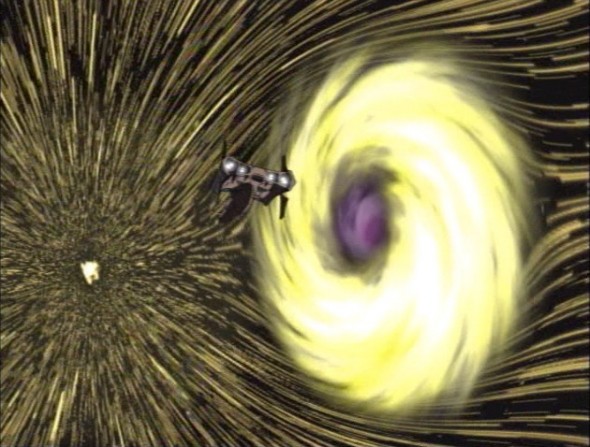 So it’s not a typical episode of Bebop, and it’s not a really a satisfying episode of the Mei Fa Mystical Adventure Happy Hour, or whatever that show would have been called. This leads me to suspect that the real point of this episode is precisely the collision between these two aesthetics – not because the results are particularly interesting, but precisely because it is a collision. A sense of things being out of place, out of order, topsy-turvy, is just all over this episode. When Jet meets Mei Fa, she vaults over a tombstone and tackles him, sending him literally head over heels.
So it’s not a typical episode of Bebop, and it’s not a really a satisfying episode of the Mei Fa Mystical Adventure Happy Hour, or whatever that show would have been called. This leads me to suspect that the real point of this episode is precisely the collision between these two aesthetics – not because the results are particularly interesting, but precisely because it is a collision. A sense of things being out of place, out of order, topsy-turvy, is just all over this episode. When Jet meets Mei Fa, she vaults over a tombstone and tackles him, sending him literally head over heels.
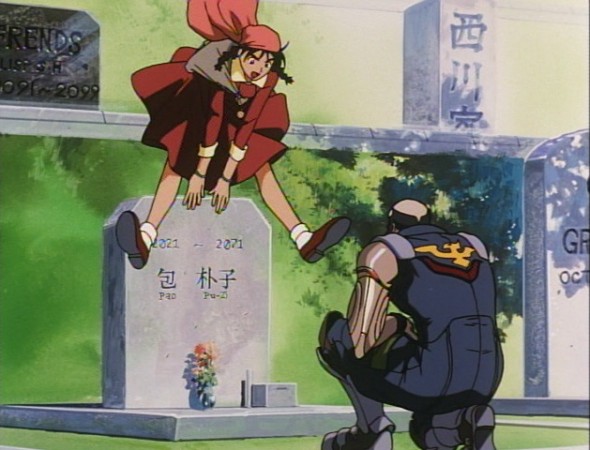
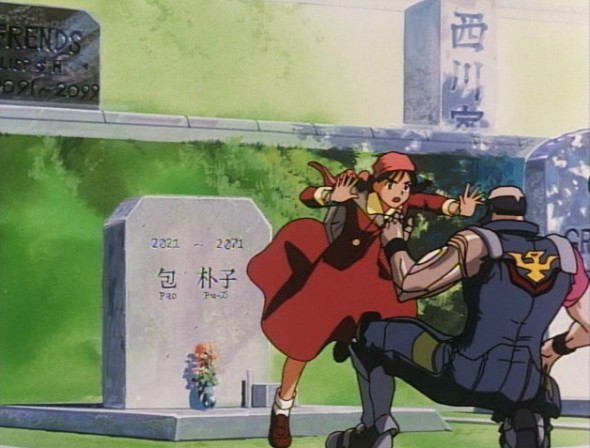
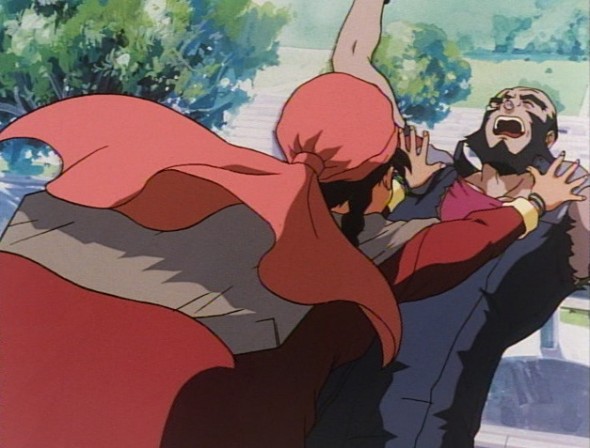
Notably, the way this is drawn disturbs our sense of the local “down”: from the way this sequence is presented, it looks like Jet should be about to fall to his death. (Like so many of Cowboy Bebop’s odd little visual moments, the still image here doesn’t really do it justice.) A few minutes later, and they’re sprinting through a hail of gunfire, the teenaged girl pulling the big burly ex-cop along by the standard female grab area.
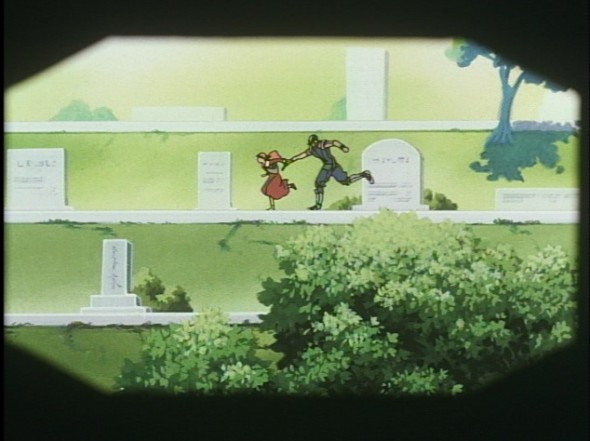
- So… is it kind of sexist to even NOTICE the reversal here?
Later on, Jet tells Faye and Spike that the Bebop is now a no-smoking area!! (The time is out of joint!) And then most noticeably, we have the breathtaking little special effects sequence pictured at the top of the page, where the hyperspace tunnel that the BeBop is flying through is joined orthogonally by the hyperspace tunnel of Pao’s doomed spaceship: a symbolic representation of the collision of Jet and Mei Fa’s stories, and what’s more their distinct narrative universes.
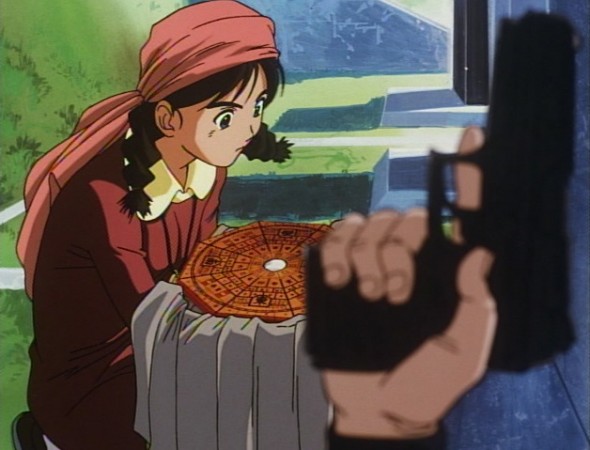
- The contrast in a nutshell. And I like how his cold hard rational firearm is all out of focus, while her magic divination compass is perfectly clear.
There’s some other important stuff going on here about fate and death (and some unimportant stuff about ice cream), but we’ll come back to that. The fate and death, I mean. For now, let’s move on.
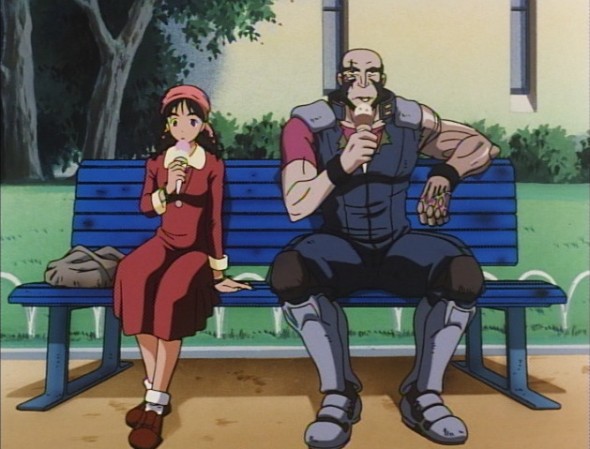
“By the way, this awesome orange color scheme is used nowhere else in the episode. In fact, the rest of it is pretty much blue, making it the extended version of that one obnoxious high-contrast color scheme they use in every single movie poster nowadays. Bebop did it before it was lame, though.”
I hope everyone is aware of this phenomenon. It’s quite striking. For an extensive gallery of examples:
http://www.slashfilm.com/2009/11/27/orangeblue-contrast-in-movie-posters/
Ah, I knew there was a gallery somewhere! I wanted to link to it but I couldn’t remember what website it was on. Thanks for that, Lee.
Although I’d call the trend more “damning” than “striking.” :-/
I can’t add anything here but I thought I would take out space and say that these articles are awesome.
Agreed. I love these articles and am really happy whenever a new one comes out.
8 pages?? F-yeah!
It’ll be a sad day when these are finished up and the series has been overthought. :D I hope you plan on doing the movie once the series is done!
One question I have about Spike’s “massive death wish.” It could be that, but I always figured Spike as a young guy to be an adrenaline junkie. He gets his thrills from dangerous situations. Unless that’s the same as a death wish. :D
I’ll probably do something about the movie… not sure quite what, though. I’ve been thinking a lot about how one could make Cowboy Bebop into a movie (because of the threatened live-action, all-Keanu-all-the-time remake), and I’m interested in how the show’s own creative team handled it. So one thought I had was to end my posts on the show itself with a list of dos and don’ts for a cinematic adaptation, and then watch the movie and see how it stacks up against that.
As for Spike’s death wish: I think at the beginning of the series, he comes off a lot more like an adrenaline junky (especially in the first episode, where he’s not interested in fighting Solensan until he realizes that the guy is nigh-indestructible), but that as the show goes on it seems more and more like he’s actually interested in finding his death, for a bunch of quasi-existential reasons. Before he goes off to fight Pierrot he actually says something like “Maybe this will finally be the one…” doesn’t he? He tries to play it off as a joke immediately afterwards, of course, but I don’t think we’re meant to believe him. I’ll go into this more in a future post, though. You bring up an interesting question.
MASSIVE SPOILER
*
*
*
*
*
*
*
*
*
*
The entire series is about death because, as we find out in the final series of episodes, Spike’s soul has basically been dead for years, and all that is left is for him to redeem his disgraceful life and die a Samurai’s death. Which of course he does.
Although, he’s marekd for death.
But, for real, the entire series is about redemption by chosing to die a good death.
In terms of Andy’s “death of cowboy identity”, what do you make of the end title reading “See You Space Samurai”? This might make the whole thing less a death than a transformation–Andy is still just as crazy, hokey and pseudo-cool as ever, he’s just swapped the superficial stereotype he’s imitating. (And even then, the cowboy stereotype arguably has a lot in common with the samurai one; you could argue that they’re similar archetypes.)
Anyway, awesome article!
I’ll see your “less a death than a transformation” and raise you a “what is death but a transformation?” When he hands Spike the hat and walks away, you’re supposed to think that his cowboy persona is dead (go ahead and put scare quotes around that if you want to). When he shows up as the samurai at the end, I find that it reads as a resurrection, or maybe a life-after-death, which amounts to pretty much the same thing.
The similarity of the cowboy and samurai archetypes is interesting, in that actual cowboys and actual samurai are about as different from each other as two groups of people have ever been. But in pop culture, they do seem to be functionally equivalent.